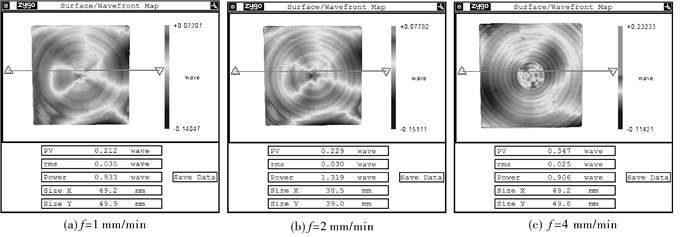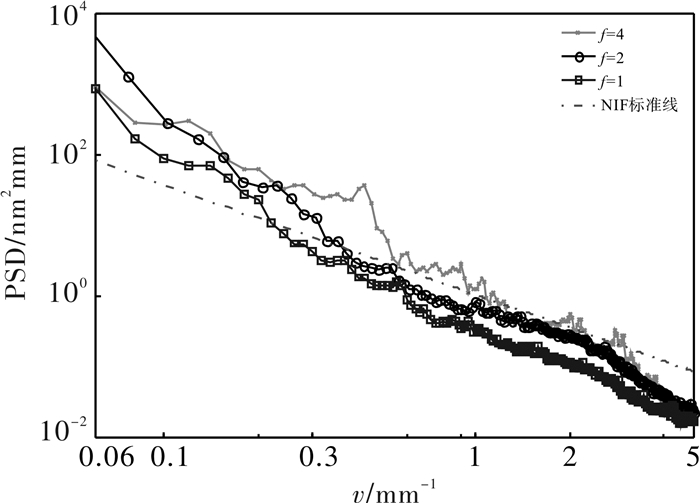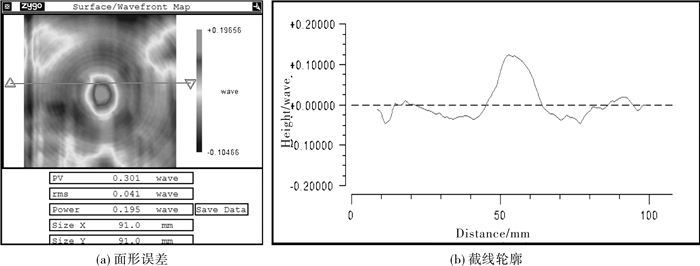Spectral characteristics and control of machining errors of KDP optical elements in ultra-precision turning
-
摘要: 超精密车削技术适于加工KDP(磷酸二氢钾)等频率转换类型的强光光学零件,但车削表面存在明显的加工纹理,导致抗激光损伤阈值降低。以加工表面误差幅值及其频谱分布为对象,分析了KDP光学零件超精密车削的加工特征和误差形态,采用功率谱密度(PSD)评价方法研究了工艺参数与误差频谱的内在关系,结果表明:不同进给速度及主轴转速将使螺旋形刀痕的间距发生变化,进而影响KDP表面误差的频率成分;切削深度虽然对误差频谱影响很小,但会改变PSD的幅值;当主轴转速高于500 r/min、进给速度小于2 mm/min、切削深度小于2 μm时能够加工出rms值优于20 nm的KDP面形。在此基础上,以典型KDP光学零件加工为例,通过超精密补偿车削方法将低频误差的PSD控制在300 nm2·mm以内,中高频误差的PSD控制到国家点火装置(NIF)标准线以下,满足强光系统的工作要求。
-
关键词:
- 光学制造 /
- KDP /
- 超精密车削 /
- 面形误差 /
- 功率谱密度(PSD)
Abstract: Ultra-precision turning technology is suitable for machining KDP optical elements which are used as frequency conversion unit in high-power laser system, but stripes are easy to come into being in machining process, and this will result in reduction of laser induced damage threshold. Taking magnitude and spectrum distribution of machining errors as researching object, machining features and error morphology of KDP elements are analyzed after ultra-precision turning in this paper, and correlation between error spectrum and machining parameters is studied based on power spectral density (PSD). Results show that feeding rate and spindle speed will change distance between spiral ripples and affect error spectrums of KDP machining surface, cutting depth has hardly any influence on spectrum of errors, but it will change magnitude of PSD. KDP surface can be accurately manufactured with rms value is smaller than 20nm when spindle speed is more than 500r/min, feeding rate is less than 2mm/min and cutting depth is less than 2 μm. According to a typical KDP element, PSD of low frequency errors is controlled within 300 nm2·mm by using ultra-precision compensating turning method, PSD of mid-to-high frequency errors is under "Not-to-Exceed" line applied in national ignition facility, and working requirements for high-power laser system are satisfied on the whole.-
Keywords:
- optical manufacturing /
- KDP /
- ultra-precision turning /
- surface error /
- power spectral density (PSD)
-
引言
KDP晶体具有优质的非线性光学特性,是惯性约束激光核聚变等强光系统非常重要的光学零件[1]。KDP质地软、易潮解、对温度变化敏感、易开裂,并且各向异性,传统的光学抛光方法并不适于其加工[2]。目前,国内外广泛采用单点金刚石车削技术对KDP光学零件进行超精密加工[3]。加工过程中,金刚石刀具沿设定轨迹将刀刃轮廓复印到被切表面上,理想情况下加工表面将出现螺旋状刀痕,含有明显的低频误差。实际加工时,由于KDP车削表面是刀具几何轮廓在各种内外扰动作用下的运动轨迹在待加工面上进行布尔减运算而成,因此加工误差含有丰富的频率成分。
德国ZEISS公司研究了表面误差的不同频率成分对光学性能的影响[4],美国劳伦斯·利弗莫尔国家实验室(Lawrence Livermore national laboratory,LLNL)采用功率谱密度(power spectral density,PSD)来表征国家点火装置(national ignition facility,NIF)中强光光学零件的中高频误差。在光学国际标准ISO 10110中,PSD成为评价光学零件表面误差的重要参数[5],NIF标准线也逐渐成为同类系统强光光学零件PSD是否合格的参考依据。
由于机床振动和几何误差等因素的影响,金刚石车削时容易在加工表面引入中高频误差[6-7],将降低KDP晶体的抗激光损伤阈值,影响其使用性能[8]。本文以KDP加工误差的PSD特性分析为基础,研究车削形貌的频谱特征和工艺参数的选用方法。
1 KDP零件超精密车削后的误差形态
超精密车削加工表面的影响因素很多,包括工件材料特性、刀具几何形状及其磨损、伺服运动误差、导轨刚度、主轴跳动等。根据Cheung的研究结论,金刚石刀具与工件之间的相对振动和走刀痕迹对表面误差的贡献最大,其次是机床动态特性的影响[9]。
KDP光学零件在单点金刚石车削后,加工表面主要由螺旋状刀痕构成,如图 1所示。为了定量分析强光光学零件受误差频谱的影响,LLNL对0.03 mm-1~8.3 mm-1频段的表面误差构造了一条标准线[10],要求误差PSD不超过这条线,即
$$ PSD \le A \cdot {\nu ^{ - b}} $$ (1) 式中:ν为误差分析频率;A=1.05;b=1.55。
图 2是利用超精密车削方法加工KDP光学零件的测量面形,金刚石刀具的刀尖圆弧半径为5 mm,进给速度为2 mm/min,主轴转速为500 r/min,切削深度为1 μm,测量仪器为Zygo波面干涉仪。从图中可以看出,表面上存在螺旋形的加工纹理,周期约在1 mm~2 mm之间。
采用(2)式,计算出超精密车削表面的二维PSD分布见图 3(a)所示。以中心为旋转点,在间隔30°的6个方向分别进行积分,生成6条一维PSD曲线,见图 3(b)所示。
$$ \begin{array}{*{35}{l}} PSD\left( {{m}_{v}}, {{n}_{v}} \right)=\frac{\Delta x\Delta y}{MN}\left| \sum\limits_{n=0}^{N-1}{\sum\limits_{m=0}^{M-1}{\phi \left( m, n \right)}}\cdot \right. \\ {{\left. \ \ \ \ \ \ \ \text{exp}\left[ -\text{i2}\pi \left( m\cdot {{{f}_{m}}}/{M}\;+n\cdot {{{f}_{n}}}/{N}\; \right) \right] \right|}^{2}} \\ \end{array} $$ (2) 式中:Δx、M为加工表面沿X方向的采样间隔和采样点数;Δy、N为Y方向的采样间隔和采样点数;φ(m, n)为测量误差;$ {{f}_{m}}={{{m}_{v}}}/{M\Delta x, {{f}_{n}}={{{n}_{v}}}/{N\Delta y, }\;}\;{-M}/{2\le {{m}_{v}}\le {M}/{2, {-N}/{2\le {{n}_{v}}\le {N}/{2}\;}\;}\;}\;$。
从图 3可以看出,超精密车削表面存在圆环状的频谱分布,在整个面形中低频误差比较突出,其值在NIF标准线之上,需要进一步修形。中高频误差虽然基本位于NIF标准线以下,但许多孤立的频率点超出了NIF标准线,这些频率成分误差是在超精密车削过程中由于工艺措施控制不好而引入的。
2 切削参数对KDP加工表面误差频谱的影响
2.1 进给速度对误差频谱的影响
实验中选用主轴转速s=500 r/min,切削深度a=1 μm,进给速度分别为f=1 mm/min、2 mm/min、4 mm/min,对口径为50 mm的KDP光学零件进行超精密车削加工。采用Zygo波面干涉仪进行检测,误差分布如图 4所示,加工表面呈现出比较明显的纹理特征。
不同进给速度时KDP零件超精密车削表面的一维PSD曲线(6方向截线中各频率点取PSD极大值构造的曲线)如图 5所示。可以看出在有效评价区域内,f=4 mm/min时加工表面存在约0.4 Hz、1.1 Hz的频率成分,f=1 mm/min、2 mm/min时该频率成分不明显;加工误差随着进给速度的降低而减小,这是因为在主轴转速不变的情况下,进给速度降低会引起加工表面上螺旋形刀痕的螺距减小,根据加工面刀具几何轮廓布尔减运算的作用结果,误差幅值、PSD值将下降。综合来看,进给速度会改变螺旋形刀痕的间距,进而影响KDP车削表面误差的频谱成分。
2.2 主轴转速对误差频谱的影响
实验中选用进给速度f=2 mm/min,切削深度a=1 μm,主轴转速分别为s=300 r/min、500 r/min、700 r/min,对KDP光学零件进行超精密车削加工。根据Zygo波面干涉仪的测量结果,发现随着主轴转速增大,加工纹理逐渐减小;这是因为主轴转速增加,加工表面上相邻刀痕的间距缩短,残留误差的幅值减小;当主轴转速达到s=700 r/min时,加工纹理已不明显。
不同主轴转速时KDP零件超精密车削表面的一维PSD曲线见图 6所示。在有效评价区域内,s=700 r/min时加工表面的低频误差(≤0.3 Hz)与s=500 r/min比较接近;当超精密机床的动态特性满足要求时,随着主轴转速增加,加工表面的误差幅值降低,中高频误差的PSD值明显下降。
2.3 切削深度对误差频谱的影响
实验中选用进给速度f=2 mm/min,主轴转速s=500 r/min,切削深度分别为a=1 μm、2 μm、4 μm,对KDP光学零件进行超精密车削加工。根据Zygo波面干涉仪的测量结果,发现加工纹理没有明显变化。不同切削深度时KDP零件超精密车削表面的一维PSD曲线如图 7所示。在有效评价区域内,切削深度对误差频谱成分的影响很小,但会在一定程度上影响PSD的幅值大小,切削深度增加,表面误差的PSD幅值也增大。
通过综合分析与验证,发现:当主轴转速高于500 r/min、进给速度小于2 mm/min、切削深度小于2 μm时超精密车削加工KDP光学零件能够得到rms值优于20 nm的加工表面。
3 典型KDP光学零件超精密车削加工实验
以应用于强光系统的某典型KDP光学零件为加工对象,其尺寸为91 mm×91 mm,通过超精密车削获得高精度光学表面,采用Zygo GPI波面干涉仪对加工面形进行测量,结果如图 8所示。可以发现加工表面的纹理分布比较明显,截线上除了中心位置具有较大的突起之外,还存在周期性的纹波,波长约为5 mm。
将KDP加工表面的一维PSD曲线与NIF标准线进行比较,找出不合格频率点,分析误差频谱的演变趋势。如图 9中“×”线所示,超精密车削表面以低频误差为主,频率低于0.1 Hz的误差幅值较大,超出了NIF标准线;频率介于0.1 Hz~0.2 Hz之间的误差在NIF标准线附近波动,频率高于0.2 Hz的高频误差在NIF标准线以下。
为了控制KDP光学零件的低频误差,对其进行超精密补偿车削。补偿加工后表面误差的PSD曲线如图 9中“□”线所示,低频误差的PSD幅值控制到300 nm2·mm以内,中高频误差的PSD位于NIF标准线以下,达到了强光系统的工作要求。
4 结论
KDP晶体具有优质的非线性光学特性,是强光系统中非常重要的光学零件。由于KDP质地软、易潮解,传统的光学抛光方法不适于其加工。超精密车削KDP光学零件时加工表面存在明显的纹理,将会降低抗激光损伤阈值,需要在误差频谱特性分析的基础上合理选用切削参数。
本文分析了KDP光学零件超精密车削的加工特征和误差形态,发现车削表面的低频误差比较突出。研究了切削参数与超精密车削表面误差频谱的内在关系,结果表明进给速度、主轴转速将影响表面误差的频谱成分,切削深度会在一定程度上影响PSD的幅值大小;在此基础上,给出了KDP光学零件超精密车削加工中工艺参数的合理取值范围。以典型KDP零件超精密车削加工为例,研究了表面误差的分布形态和演变趋势;通过补偿车削方法,将低频误差的PSD控制到300 nm2·mm以内,中高频误差的PSD位于NIF标准线以下,满足强光系统的工作性能要求。
-
-
[1] Hawley-Fedder R, Geraghty P, Locke S, et al. NIF pockels cell and frequency conversion crystals[J]. SPIE, 2004, 5341: 121-126. http://d.old.wanfangdata.com.cn/NSTLHY/NSTL_HYCC026387386/
[2] Hu H, Dai Y F, Peng X Q.Research on reducing the edge effect in magnetorheological finishing[J]. Applied Optics, 2011, 50(9): 1220-1226. doi: 10.1364/AO.50.001220
[3] Tie G P, Dai Y F, Guan C L, et al. Research on full-aperture ductile cutting of KDP crystals using spiral turning technique[J]. Journal of Materials Processing Technology, 2013, 213(12): 2137-2144. doi: 10.1016/j.jmatprotec.2013.06.006
[4] Meiling H, Banine V, Kürz P, et al. The EUV program at ASML: an update[J]. SPIE, 2003, 5037: 24-35. http://cn.bing.com/academic/profile?id=e9d799c8868281ca1fb26698de0f10d5&encoded=0&v=paper_preview&mkt=zh-cn
[5] ISO 10110-8. Annex B: Relationship between surface texture and scattering characteristic of textured surfaces[S]. Switzerland: International Organization for Standardization, 2001.
[6] 李富仁.强光光学零件的中高频误差研究[D].长沙: 国防科技大学, 2013. Li Furen. Study on medium-high frequency errors of optical elements used in high-power system[D]. Changsha: National University of Defense Technology, 2013.
[7] Wang G L, Dai Y F, Zheng Z W, et al. Machining characteristics of complex surfaces using fast tool servo system[J]. Machining Science and Technology, 2011, 15(3): 324-337. doi: 10.1080/10910344.2011.600199
[8] Xie N, Guo Y, Huang W Q, et al. Improvement of near-field beam quality for high-power laser pulses by a two-photon-absorption organic compound[J]. Optik, 2013, 124(1): 60-63. doi: 10.1016/j.ijleo.2011.11.041
[9] Cheung C F, Lee W B. A multi-spectrum analysis of surface roughness formation in ultra-precision machining[J]. Precision Engineering, 2000, 24(1): 77-87. doi: 10.1016/S0141-6359(99)00033-1
[10] Mackinnon A J, Niemann C, Piston K, et al. Qualification of a near backscattering imaging system on the national ignition facility[J]. Rev. Sci. Instrum., 2006, 77(10): 10E529-10E529-4. doi: 10.1063/1.2336466
-
期刊类型引用(5)
1. 束梓豪,庞启龙,况良杰. KH_2PO_4晶体已加工表面频率特征对亚表层温度场的影响. 中国机械工程. 2022(16): 1983-1991 .  百度学术
百度学术
2. 景文芳. 嵌入式光网络传输数据自动纠错系统设计. 激光杂志. 2020(01): 181-184 .  百度学术
百度学术
3. 李文卿,张继友,王永刚,马仙梅,孟晓辉,李昂. 离子束加工中全频段误差的演变. 航天返回与遥感. 2020(05): 47-54 .  百度学术
百度学术
4. 王贵林,李完小,向纪邦. 强光光学零件磁流变抛光误差的频谱特征与演变研究. 航空精密制造技术. 2019(01): 6-9+35 .  百度学术
百度学术
5. 况良杰,庞启龙,徐幼林. 超精加工表面形貌任意频率的提取及重构. 工具技术. 2018(10): 62-66 .  百度学术
百度学术
其他类型引用(4)




 下载:
下载:









 陕公网安备 61011302001501号
陕公网安备 61011302001501号 